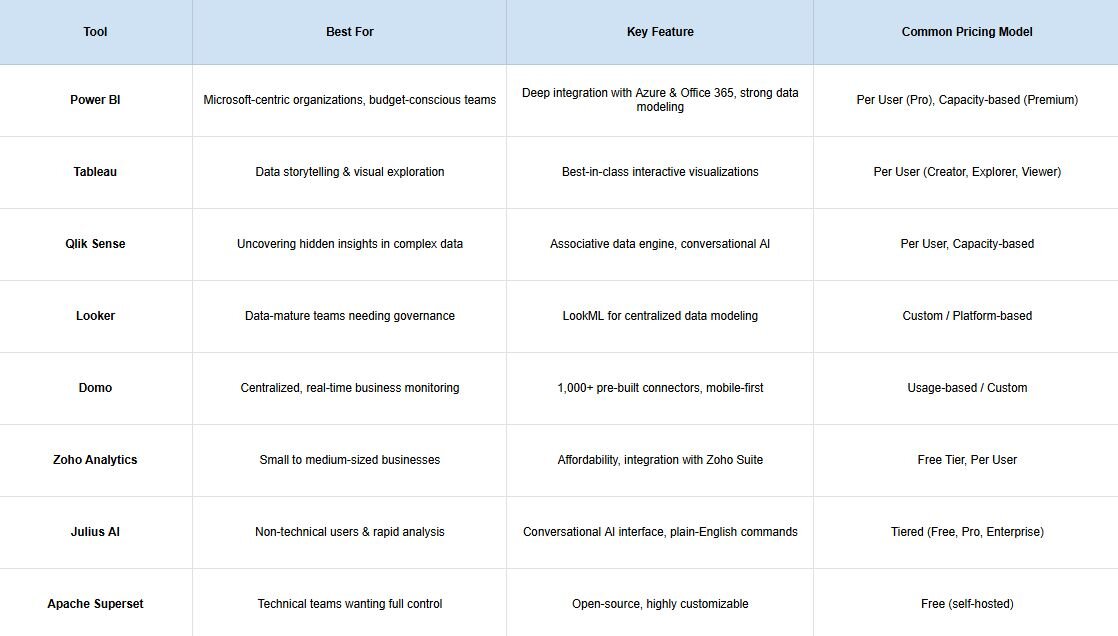July 15th, 2025
Best Power BI Alternatives: AI-Powered Insights Made Easy
By Simon Avila · 5 min read

Microsoft Power BI is a dominant force in the business intelligence (BI) landscape, prized for its deep integration with the Microsoft ecosystem and its relatively low entry cost [1]. However, as organizations' data needs evolve, many find themselves searching for alternatives that offer different strengths—be it more advanced visualizations, better handling of non-Microsoft data, a more intuitive user experience, or a different approach to AI and analytics.
This article explores the top Power BI alternatives, from enterprise-grade platforms to nimble, AI-powered tools, helping you find the perfect fit for your team's skills, budget, and data strategy.
Why Look for a Power BI Alternative?
While powerful, Power BI isn't a one-size-fits-all solution. Teams often seek alternatives for several key reasons:
• Steep Learning Curve: Mastering Data Analysis Expressions (DAX), Power BI's formula language, can be a significant hurdle for non-technical users.
• Visualization Limitations: While capable, some teams require more advanced or flexible visualization capabilities than Power BI offers out of the box.
• Ecosystem Lock-in: Organizations not heavily invested in the Microsoft stack (e.g., Azure, Office 365) may find other tools integrate more seamlessly with their existing infrastructure, like Google Cloud or AWS [2].
• Performance at Scale: With extremely large and complex datasets, some users report performance limitations that lead them to explore more specialized solutions [3].
Top Power BI Alternatives for Every Need
The BI market is rich with options catering to different users, from data scientists to business analysts. Here’s a breakdown of the leading contenders.
The Enterprise Powerhouses
These platforms are direct competitors to Power BI, offering comprehensive, large-scale analytics solutions.
Tableau: The Visualization Leader
Tableau is renowned for its best-in-class interactive visualization capabilities. Its intuitive drag-and-drop interface allows users to create complex dashboards from various data sources in real-time [1].
• Key Strengths: Superior, flexible visualizations; strong self-service analytics; and advanced AI features like Tableau Agent for automated insights [3].
• Best For: Organizations that prioritize data storytelling and visual exploration, including large enterprises and dedicated data analyst teams.
• Considerations: Tableau often comes with higher ongoing costs and can experience performance issues with particularly complex datasets [3].
Qlik Sense: The Associative Engine
Qlik Sense stands out with its unique associative data model. This engine allows users to explore data from all angles without being limited by predefined, query-based paths. It reveals hidden insights by showing which data is and isn't associated with your selections.
• Key Strengths: Real-time insights, conversational analytics using natural language, and powerful machine learning features [4]. It supports both SaaS and on-premises deployments for flexibility [3].
• Best For: Teams needing to analyze complex data efficiently and uncover non-obvious relationships in their datasets.
The Cloud-Native & Integrated Platforms
These tools are built for the cloud and excel at integrating with modern data stacks.
Looker (Google Cloud): The Data Modeling Specialist
Now part of Google Cloud, Looker is a top choice for organizations seeking deep integration with cloud data warehouses and advanced data modeling [3]. Its power lies in LookML, a proprietary modeling language that allows data teams to define business metrics and logic centrally.
• Key Strengths: Robust data governance through LookML, support for over 50 SQL dialects, and powerful APIs for embedding analytics anywhere [4].
• Best For: Data-mature organizations with strong SQL skills that want to build a reliable, single source of truth for their data.
• Considerations: Looker has a steeper learning curve, particularly for non-technical users [4].
Domo: The All-in-One Cloud Platform
Domo is a fully cloud-based platform designed for end-to-end data integration and analysis. It boasts over 1,000 pre-built data connectors, making it easy to centralize data from across your business [4].
• Key Strengths: Mobile-first design, real-time collaboration, drag-and-drop ETL (Extract, Transform, Load) tools, and customizable alerts for key metrics [5].
• Best For: Businesses of all sizes that need a centralized, real-time view of their operations without extensive coding.
User-Friendly & Niche Solutions
These tools focus on specific use cases, from small business analytics to embedded BI.
Zoho Analytics: The SMB Champion
Zoho Analytics is a self-service BI platform that offers a powerful combination of affordability and functionality, making it a favorite among small to medium-sized businesses (SMBs) [6].
Sisense: The Embeddable & Flexible Option
Sisense provides a highly flexible platform with no-code, low-code, and pro-code options, catering to everyone from business users to developers [4]. It is particularly strong in embedded analytics, allowing companies to infuse insights directly into their own applications.
• Key Strengths: AI-assisted analytics, predictive modeling, and strong customization tools. Its pricing is also noted as being competitive with Power BI [7].
• Best For: Companies looking to embed analytics into customer-facing products or internal workflows.
The Open-Source & Developer-Focused Tools
For teams with technical expertise, open-source tools offer unparalleled customization and control.
As a leading open-source data exploration platform, Apache Superset offers a rich set of features without the licensing fees of commercial software.
• Key Strengths: A wide array of visualization types, a powerful SQL editor, an extensible security model, and connectivity to most SQL-speaking databases [8].
• Best For: Technically proficient teams that want a highly customizable, scalable, and cost-effective BI solution.
The New Wave: Conversational AI for Data Analysis
While traditional BI tools have become more powerful, a new category of tools is emerging that changes the user interaction model entirely. Instead of relying on drag-and-drop interfaces or code, these platforms use conversational AI to democratize data analysis.
Julius AI: Your AI Data Analyst
Julius AI represents this new frontier. It is an AI-powered data analysis platform that allows anyone to analyze data, create visualizations, and derive insights simply by asking questions in plain English. You can upload a file (like a CSV or Excel spreadsheet), connect to data sources, and start a conversation with your data.
• Key Strengths: No coding or complex interface navigation required. It can perform tasks like data cleaning, transformation, statistical analysis, and chart generation through simple text commands.
• Best For: Knowledge workers, marketers, and operations managers who need quick answers from data but don't have dedicated analyst support. It also serves data scientists who want to automate tedious, manual tasks and accelerate their workflow.
• How it's different: It lowers the barrier to entry for sophisticated data analysis far beyond what traditional BI tools can offer, truly making AI-powered insights easy and accessible.
How to Choose the Right Power BI Alternative
The best tool depends entirely on your organization's unique context. Use this table as a starting point to guide your decision.

Frequently Asked Questions (FAQs)
What is the best free alternative to Power BI?
Is Tableau better than Power BI?
Neither is definitively "better." They serve different priorities. Tableau generally leads in visualization flexibility and aesthetics, making it a favorite of data artists and analysts [1]. Power BI is often more affordable and excels in data modeling and integration within the Microsoft ecosystem [2].
Can I use AI for data analysis without learning to code?
Absolutely. This is where the new generation of AI-native tools shines. Platforms like Julius AI are designed specifically for this purpose, allowing you to perform complex analysis and generate visualizations through a simple, conversational chat interface, no coding required.
